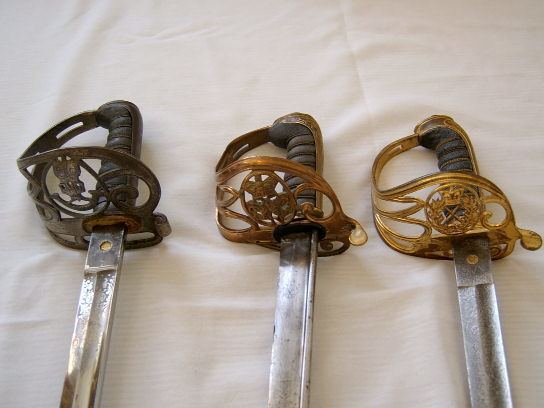 | ||
The gothic hilted swords were a family of swords carried by officers and some NCOs of the British Army between 1822 and the present day. They were primarily infantry swords, although they were also regulation pattern for some other officers such as surgeons and staff officers. The term “Gothic hilt” is derived from a perceived similarity between the curved bars of the guard and the arches found in Gothic architecture. They were elegant aesthetically pleasing weapons, although they were generally considered as mediocre fighting swords. Despite this the weapon and its variants had a very long service life.
Contents
- Private purchase
- 1822 pattern infantry officers sword
- 1845 pattern infantry officers sword
- 1892 pattern infantry officers sword
- Steel hilted swords
- Variations
- References
They were replaced with the 1897 pattern British infantry officer's sword.
Private purchase
Although sergeants' swords were issued by the army, officers were expected to purchase their own. In theory they were required to purchase a sword which conformed to an official pattern, however some regiments had their own peculiarities and some allowed their officers some leeway in specification, so there are variations between individual pieces. Also, minor differences between individual manufacturers' examples exist, partly due to their own unique interpretations of the specification for the weapon.
1822 pattern infantry officer’s sword
The 1822 dress regulations mandated the introduction of a new sword, to replace the 1803 flank officer's sabre and the spadroon bladed 1796 infantry officer's sword.
The sword featured a 32.5 inches (826mm) long, slightly curved blade of what was known as the “pipe-back” or “quill-back” design. This consisted of a flat, un-fullered, single edged blade with a nearly straight rod running along the back of the blade, with a “false edge” being formed near to the tip. The blades were generally extensively decorated with etched, or occasionally blued and gilt, patterns.
The gilded brass, “half-basket” hilt featured the characteristic, Gothic tracing and the monarch’s cipher in the guard and an ornate one piece pommel and backpiece. The inside of the guard folded towards the grip to allow the sword to rest easily against the wearer’s side. The grip was covered in fish skin and wrapped with brass or silver wire.
Although the pipe reinforcing was intended to add rigidity for the thrust and strength for the cut, the blade was rather flexible. The half basket guard gave better protection to the hand than its predecessor, the 1796 pattern, however the thin brass was fragile as illustrated by many extant examples having damage or repair.
1845 pattern infantry officer’s sword
In 1845, the pipe backed blade was replaced by Wilkinson’s design. Again, this was a slightly curved cut-and-thrust blade of the same length of the previous pattern, however the new blade featured a single, wide fuller and a flat back, rather than the pipe back.
The hilt remained essentially unchanged, although the hinged flap disappeared in 1854.
Direct comparison of the two blades shows that the new weapon was, indeed, an improvement, being stiffer in bending and compression, although it is still rather delicate for a fighting sword.
1892 pattern infantry officer's sword
The 1845 sword enjoyed a long service life and was used successfully in colonial wars all over the world, often winning the praise of British soldiers who used it to defend their lives. However, in 1892 proponents of the theory that thrust should be used exclusively over cutting for swords prevailed and the cut and thrust blade was replaced by a straight dedicated thrusting blade with a thick, fullered, dumbbell section and a sharp spear point. A stronger sword, unburdened by the design compromises of a requirement to cut well, this was a triumph of academic theory over real world experience, although good soldiers can make the best of whatever equipment is available (Robson reports on its good performance against the Dervishes in the Sudan. It was during the Sudan campaign when a young Winston Churchill sheathed his sword before the charge and used his then shockingly modern Mauser Broomhandle semiautomatic pistol). Ironically the infantry were finally being given a new weapon as rifled and repeating firearms had rendered them almost entirely obsolete so there has not been any reason to replace the model 1897 sword with its poor cutting ability since it has been used almost exclusively for ceremonial purposes almost from the time it was adopted.
In 1895 the brass Gothic hilt was replaced by a pressed steel guard which brought to an end more than 70 years of service for the line infantry.
Steel hilted swords
In 1827, officers of the rifle regiments (considered somewhat of an elite) were authorised to carry their own variation of the sword. The blade was that of the 1822 pattern sword (changing, along with the line infantry, to a fullered blade in 1845). The hilt was of the Gothic pattern but in steel with the crown and stringed bugle motif of the light infantry replacing the royal cypher. the steel guards were often less well rendered than that of the brass hilts. There was no folding flap. The pattern is still current for the light infantry regiments.
In 1854, the regiments of the Foot Guards were also required to carry a steel hilted sword. This was the same weapon as for the rifle regiments, but with the regimental badge in place of the stringed bugle. Similarly, this is still the regulation pattern for guards officers to the present day.
Variations
Sergeants' swords were similar to those for officers, but generally had undecorated blades and moulded brass, rather than fish-skin grips.
Staff officers throughout most of the period carried a brass hilted sword, but with the crossed baton staff symbol in place of the royal cipher. Generals carried the same sword as their staff, until they were formally replaced by a Mameluke style sword in 1831.
